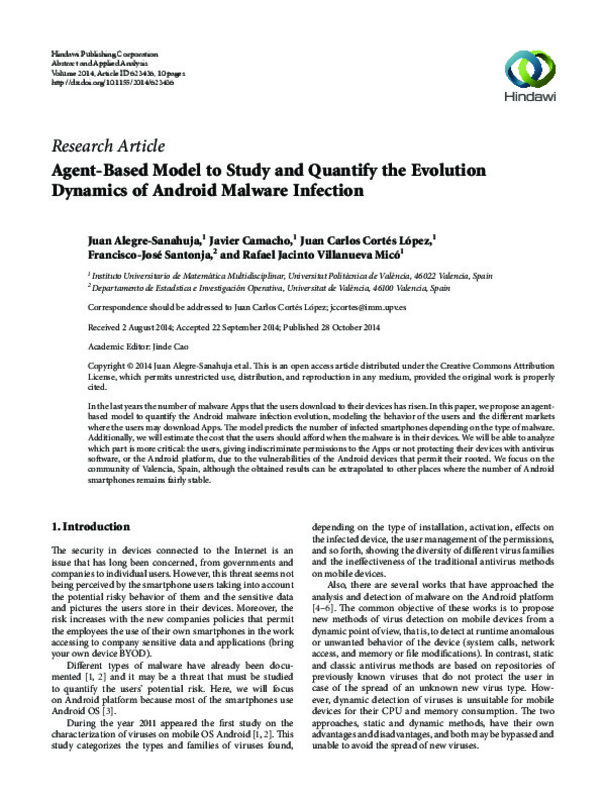JavaScript is disabled for your browser. Some features of this site may not work without it.
Buscar en RiuNet
Listar
Mi cuenta
Estadísticas
Ayuda RiuNet
Admin. UPV
Agent-Based Model to Study and Quantify the Evolution Dynamics of Android Malware Infection
Mostrar el registro sencillo del ítem
Ficheros en el ítem
| dc.contributor.author | Alegre Sanahuja, Juan
|
es_ES |
| dc.contributor.author | Camacho Vidal, Francisco Javier
|
es_ES |
| dc.contributor.author | Cortés López, Juan Carlos
|
es_ES |
| dc.contributor.author | Santonja, Francisco-José
|
es_ES |
| dc.contributor.author | Villanueva Micó, Rafael Jacinto
|
es_ES |
| dc.date.accessioned | 2015-05-20T11:43:35Z | |
| dc.date.available | 2015-05-20T11:43:35Z | |
| dc.date.issued | 2014-10-28 | |
| dc.identifier.issn | 1085-3375 | |
| dc.identifier.uri | http://hdl.handle.net/10251/50558 | |
| dc.description.abstract | [EN] In the last years the number of malware Apps that the users download to their devices has risen. In this paper, we propose an agentbased model to quantify the Android malware infection evolution, modeling the behavior of the users and the different markets where the users may download Apps. The model predicts the number of infected smartphones depending on the type of malware. Additionally, we will estimate the cost that the users should afford when the malware is in their devices. We will be able to analyze which part is more critical: the users, giving indiscriminate permissions to the Apps or not protecting their devices with antivirus software, or the Android platform, due to the vulnerabilities of the Android devices that permit their rooted. We focus on the community of Valencia, Spain, although the obtained results can be extrapolated to other places where the number of Android smartphones remains fairly stable. | es_ES |
| dc.description.sponsorship | This work has been partially supported by the Ministerio de Econom´ıa y Competitividad Grant MTM2013-41765-P. | |
| dc.language | Inglés | es_ES |
| dc.publisher | Hindawi Publishing Corporation | es_ES |
| dc.relation.ispartof | Abstract and Applied Analysis | es_ES |
| dc.rights | Reconocimiento (by) | es_ES |
| dc.subject.classification | MATEMATICA APLICADA | es_ES |
| dc.title | Agent-Based Model to Study and Quantify the Evolution Dynamics of Android Malware Infection | es_ES |
| dc.type | Artículo | es_ES |
| dc.identifier.doi | 10.1155/2014/623436 | |
| dc.relation.projectID | info:eu-repo/grantAgreement/MINECO//MTM2013-41765-P/ES/METODOS COMPUTACIONALES PARA ECUACIONES DIFERENCIALES ALEATORIAS: TEORIA Y APLICACIONES/ | es_ES |
| dc.rights.accessRights | Abierto | es_ES |
| dc.contributor.affiliation | Universitat Politècnica de València. Departamento de Matemática Aplicada - Departament de Matemàtica Aplicada | es_ES |
| dc.contributor.affiliation | Universitat Politècnica de València. Instituto Universitario de Matemática Multidisciplinar - Institut Universitari de Matemàtica Multidisciplinària | es_ES |
| dc.description.bibliographicCitation | Alegre Sanahuja, J.; Camacho Vidal, FJ.; Cortés López, JC.; Santonja, F.; Villanueva Micó, RJ. (2014). Agent-Based Model to Study and Quantify the Evolution Dynamics of Android Malware Infection. Abstract and Applied Analysis. 2014:1-10. https://doi.org/10.1155/2014/623436 | es_ES |
| dc.description.accrualMethod | S | es_ES |
| dc.relation.publisherversion | http://dx.doi.org//10.1155/2014/623436 | es_ES |
| dc.description.upvformatpinicio | 1 | es_ES |
| dc.description.upvformatpfin | 10 | es_ES |
| dc.type.version | info:eu-repo/semantics/publishedVersion | es_ES |
| dc.description.volume | 2014 | es_ES |
| dc.relation.senia | 277059 | |
| dc.contributor.funder | Ministerio de Economía y Competitividad | |
| dc.description.references | Di Cerbo, F., Girardello, A., Michahelles, F., & Voronkova, S. (2011). Detection of Malicious Applications on Android OS. Lecture Notes in Computer Science, 138-149. doi:10.1007/978-3-642-19376-7_12 | es_ES |
| dc.description.references | Shabtai, A., Kanonov, U., Elovici, Y., Glezer, C., & Weiss, Y. (2011). «Andromaly»: a behavioral malware detection framework for android devices. Journal of Intelligent Information Systems, 38(1), 161-190. doi:10.1007/s10844-010-0148-x | es_ES |
| dc.description.references | Bose, A., & Shin, K. G. (2011). Agent-based modeling of malware dynamics in heterogeneous environments. Security and Communication Networks, 6(12), 1576-1589. doi:10.1002/sec.298 | es_ES |
| dc.description.references | Wang, P., Gonzalez, M. C., Hidalgo, C. A., & Barabasi, A.-L. (2009). Understanding the Spreading Patterns of Mobile Phone Viruses. Science, 324(5930), 1071-1076. doi:10.1126/science.1167053 | es_ES |
| dc.description.references | Mylonas, A., Kastania, A., & Gritzalis, D. (2013). Delegate the smartphone user? Security awareness in smartphone platforms. Computers & Security, 34, 47-66. doi:10.1016/j.cose.2012.11.004 | es_ES |
| dc.description.references | Hoare, A., Regan, D. G., & Wilson, D. P. (2008). Sampling and sensitivity analyses tools (SaSAT) for computational modelling. Theoretical Biology and Medical Modelling, 5(1), 4. doi:10.1186/1742-4682-5-4 | es_ES |








